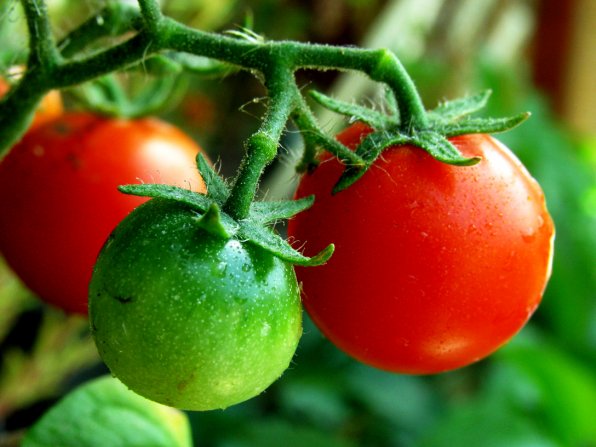“There's a green one and a pink one and a blue one and a yellow one. . .” Okay, maybe not a blue one as in the 1960s satirical tune “Little Boxes,” made famous by Pete Seeger. Certainly, though, they exist in a multitude of colors, stripes, shapes, sizes and textures. What am I talking about? Tomatoes!
No self-respecting gardener's litany of produce is complete without at least one variety of tomato. New England gardeners are as adamant in their tomato opinions as they are about the weather. Buy those hard, tasteless cardboard grocery store wannabes that try to pass for this seasonal ambrosia and you won't be welcome at barbecues for weeks to come.
The tomato is native to South America, where it was domesticated from a small yellow fruit similar to a cherry tomato. In a roundabout fashion – by way of the Spanish – tomatoes eventually arrived in the States. At first, colonial Americans shunned them as food, believing that tomatoes' poison (tomatoes are a member of the nightshade family) would turn the blood into acid. Eventually, common sense prevailed and the tomato was on its way to its current popularity.
Is it a fruit or a vegetable? Botanically, the tomato is a fruit, but it is considered a vegetable for most culinary uses. The U.S. Supreme Court even weighed in on the issue in 1893, declaring it a vegetable and, therefore, eligible for a tariff. This was based on the definition, popular at the time, that tomatoes were typically served with dinner and not with dessert.
There are approximately 7,500 tomato varieties grown for different purposes. Heirloom tomatoes are gaining in popularity, producing more interesting and flavorful crops. Hybrid plants remain common as they are heavy producers and somewhat “rugged.”
Varieties are roughly based mostly on shape and size. Slicing tomatoes are used for processing and eating fresh. Beefsteaks are used for sandwiches. Plum or paste tomates have higher solids content for use in sauce or paste. Cherry tomatoes are small and often sweet. But have you heard about Campari tomatoes? They're bigger than cherries, smaller than plums, juicy and low acid. Oxheart tomatoes are shaped like strawberries, and pear tomatoes make the richest gourmet tomato paste.
Visit your local farmers' market for the opportunity to taste the multitude of varieties.
The poor taste and lack of sugar found in many commercial tomato varieties results from breeding tomatoes which ripen uniformly red. Commercial cultivars are bred for factors including consistent size and shape, disease and pest resistance, suitability for mechanical picking, packing, and shipping, and the ability to be picked before fully ripened. In the world food market, China produced one quarter of the global output in 2010, followed by the United States and India.
Home gardeners pick varieties primarily based on taste.
Tomatoes are relatively easy to grow. They need about seven hours of direct sun and they like heat and even watering. Soil should be well-composted with a little lime added. They are tender and will not tolerate frost. They can be grown in gardens, pots, barrels and even upside down! In Concord, there is a driveway on Auburn Street that is lined every year with clay pots yielding a bounty of produce! Consider “determinates” versus “indeterminates.” Determinates are bush-type plants, good for container growing. They are also preferred by commercial growers who wish to harvest a whole field at once. Indeterminates are varieties that vine, continuing to produce until frost. These generally require some sort of support-of which there are many – cages, ladders, stakes, etc.
Common pests include stinkbugs, mites, slugs, aphids, cutworms and the notorious hornworm. Tomato hornworms can devastate a plan-and ruin your harvest. Keep an eye on your plants for tell-tale signs of green poop and stripped leaves.
If you find the culprit, don't hesitate to squish it unless it is covered with little white, rice-like wasp larvae. These are parasitic and will kill the hornworm while benefiting your garden as pollinators. Planting tomatoes amongst parsley, queen anne's lace, and dill may attract these wasps. Planting tomatoes amongst strong-smelling plants such as alliums (like onions, garlic, chives) and mints (basil, oregano, and spearmint) may actually disguise the smell of the tomato, thus protecting it from pests.
I live a couple of miles away from my community garden – too far to satisfy my immediate cravings for these treats. Solution: I have a big self-watering planter strategically placed for optimal sun (think road), with two varieties of cherry tomatoes (Sungolds – my absolute favorite!), just outside my front door. I grab a handful on my way to and from work. I must admit, I've had a kind of garden varmint to deal with at home. Poachers, in the form of neighborhood children, cheeks pouched like those of chubby chipmunks, juices dribbling down chins.
Nothing speaks of summer like a freshly picked, ripe garden tomato!
Karen Shields gardens on her community garden plot in Concord. To enjoy tasting varieties of heirloom tomatoes and learn about saving seeds, join the Capital Area Organic Gardeners on Sept. 19 at 7 p.m. at the Grace Episcopal Church. For more information,visit ccognh.wordpress.com.









